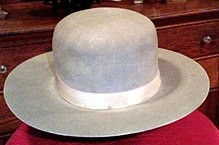The Cowboy Hat
- darrenransley
- Apr 19, 2021
- 3 min read
Interview any Brit (and hundreds of other eastern countrymen) and they will
tell you that the cowboy hat is a symbolic and iconic emblem associated with
the United States. The cowboy hat is a prominent element in the western films
they enjoy, the country songs they listen to and the masculine image
portrayed in American advertisements (think Marlboro cigarettes, Jimmy Dean
sausage and Dodge Ram trucks).
I choose to wear a high-crowned, wide-brimmed, soft-felt hat best known as
the defining piece of attire representing the North American cowboy and
recognized around the world as part of Old West values, lifestyle and
advocacy.
COWBOY HAT FOUNDING
The concept of a broad-brimmed hat with a high crown worn by a rider on
horseback can be seen as far back as the Mongolian horsemen of the 13th
century. The tall crown provides insulation and the wide brim provides shade
and is useful in hot and sunny climates (very wide brims were inspired by
the sombrero of Mexico).
In early days, European-Americans in the Western United States originally
had no standard headwear. People moving West wore many styles of hat,
including top hats, bowlers, remains of Civil War headgear, and sailor hats.
Contrary to popular belief, it was the bowler and not the cowboy hat that was
the most popular in the American West, prompting Lucius Beebe to call it "the
hat that won the West".
Hard-working cowboys began wearing wide-brimmed and high-crowned hats
adopted from the Mexican Vaqueros before the invention of the modern
design and various spin-offs.

John Batterson Stetson is credited for originating the modern day American
Cowboy Hat.
COWBOY HAT HISTORY
The original "Boss of the Plains" hat, manufactured by Stetson in 1865, was
flat-brimmed, had a straight sided crown, with rounded corners.
These light-weight, waterproof hats were natural in color with four-inch crowns
and brims and were typically fitted to each head size.
While only making one style of hat, they came in different qualities ranging
from one-grade material at five dollars apiece to pure beaver felt hats for thirty
dollars each. And while J.B. Stetson’s marketed the "Boss of the Plains" to
cowboys, it was an indispensable item in every man's wardrobe in the 19th
century and first half of the 20th century.
Stetson focused on high-value, high-quality hats that represented a real
investment for the working cowboy which doubled as a ‘statement of success’
for the city dweller.

President Ronald Reagan demonstrated the popularity of the cowboy hat as a
movie star, as a resident of the American west, and as a horseback rider.
COWBOY HAT GENTLEMANLY TIPS
1. Know When to Remove Your Hat
The first rule is knowing when to remove your cowboy hat. During the
National Anthem, Pledge of Allegiance, the passing of the flag, in church,
during prayer, and during a funeral procession -- all require the hat to go.
Also, remove your hat when introduced to a woman. You can hold the hat
in one hand while you shake her hand in greeting with the other. Last but
not least, remove your hat when entering a building or private home, when
you begin a new conversation or sit down to dine in a restaurant.
2. Pick the Right Hat for the Season
The straightforward guideline follows common sense. Originally the felt hats
were meant to keep the head warm on cold nights in the winter while the
straw hats would shade from the sun but allow air to pass through keeping
you cool in the summer. Make practical choices because it doesn't make
sense to sweat in winter wear when its 100 degrees outside.
3. Handle Your Hat the Right Way
Hold your hat the right way by holding it by the crown so that no one can
see the lining.
4. Tip Your Hat
Cowboys tip their hats to ladies when outdoors, remove them when being
introduced, and always remove them when entering a lady’s home.
Note: Forget about the movies. Men never tipped their hats to other men in
the Old West. It was akin to calling them a woman. A nod was as common
greeting when not shaking hands.
5. Never Mess with Another Cowboy's Hat
The most important rule of cowboy hat etiquette is to never mess with
another gentleman’s hat. Not only is it considered bad luck, but this is an
extremely personal (and often expensive) item.
If you follow my BLOGs, you already know I have a huge passion and
respect for the American West and all of its glorious stories. In moving from
Washington state to beautiful Oklahoma in 1985 (and with the start of my
first little herd of black angus cattle), it was an easy choice to adopt the
cowboy hat as part of my wardrobe.
Whether you don the cowboy hat or not, God bless you, God bless your
family, and God bless the American West and this great country.
Best regards,
Bob


























A Mens Western Denim Jacket is a versatile workhorse that never goes out of style. It’s perfect for layering and adds a rugged touch to any outfit. Find classic and modern cuts at Western Jacket.